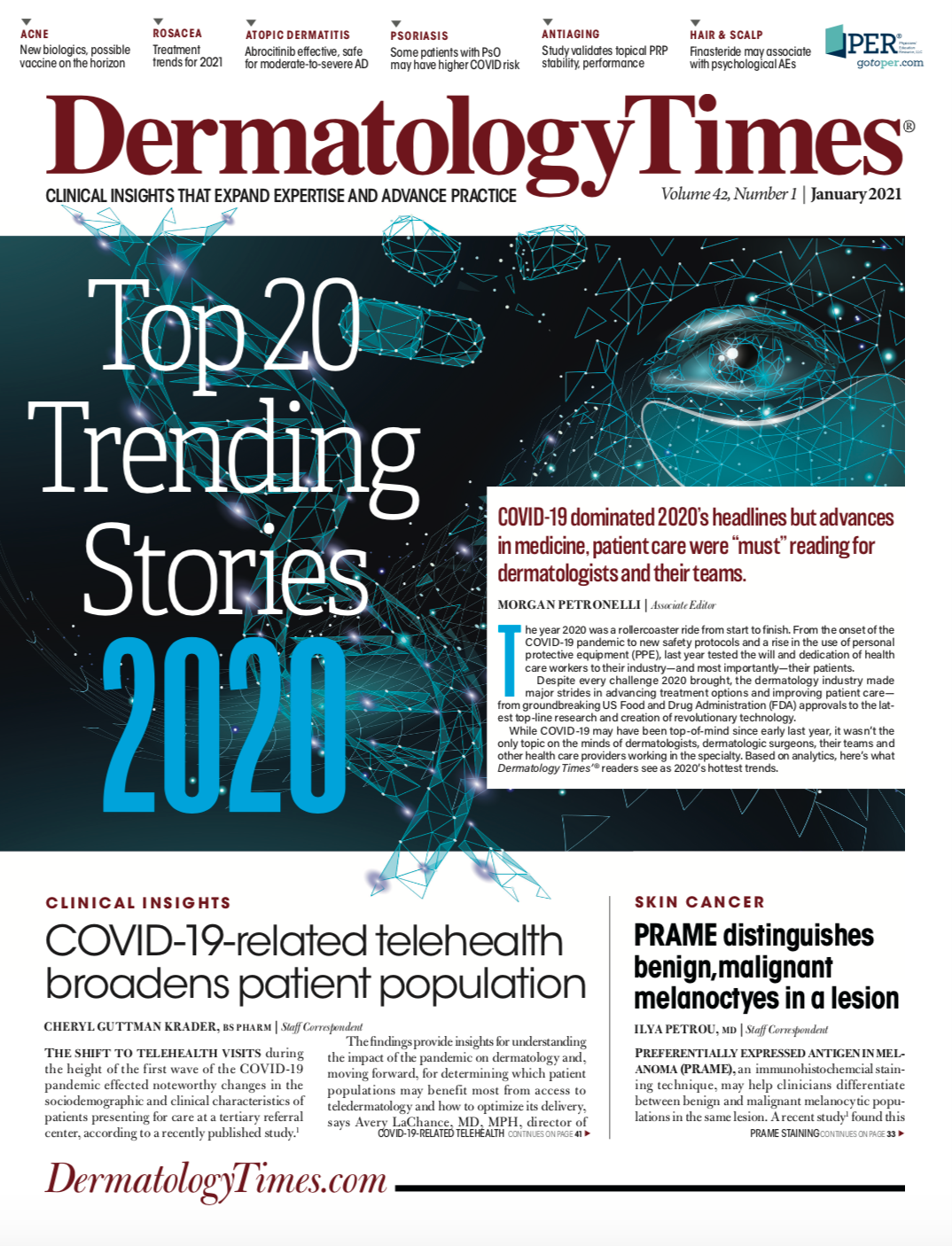
- Case-Based Roundtable
- General Dermatology
- Eczema
- Chronic Hand Eczema
- Alopecia
- Aesthetics
- Vitiligo
- COVID-19
- Actinic Keratosis
- Precision Medicine and Biologics
- Rare Disease
- Wound Care
- Rosacea
- Psoriasis
- Psoriatic Arthritis
- Atopic Dermatitis
- Melasma
- NP and PA
- Skin Cancer
- Hidradenitis Suppurativa
- Drug Watch
- Pigmentary Disorders
- Acne
- Pediatric Dermatology
- Practice Management
- Prurigo Nodularis
- Buy-and-Bill
Publication
Article
Dermatology Times
COVID-19-Related Telehealth Broadens Patient Population
Author(s):
A retrospective study shows significant differences in the characteristics of patients seen by telehealth during the COVID-19 pandemic versus those seen during in-office visits 1 year earlier.
The shift to telehealth visits during the height of the first wave of the COVID-19 pandemic effected noteworthy changes in the sociodemographic and clinical characteristics of patients presenting for care at a tertiary referral center, according to a recently published study.1
The findings provide insights for understanding the impact of the pandemic on dermatology and, moving forward, for determining which patient populations may benefit most from access to teledermatology and how to optimize its delivery, says Avery LaChance, MD, MPH, director of Health Policy and Advocacy, Brigham and Women’s Hospital Department of Dermatology, and instructor in Dermatology, Harvard Medical School, Boston, Mass.
“It is essential that we study how the rapid expansion of telehealth throughout the pandemic impacted our patients and the practice of medicine,” says LaChance. “As a medical community, we should seek to learn as much as possible about how we can optimize telemedicine to improve patient access to dermatologic care.”
To evaluate the impact of the transition to telehealth on the practice of dermatology, LaChance and colleagues at the University of Massachusetts Department of Dermatology conducted a retrospective chart review comparing the characteristics of patients seen for in-person visits in April 2019 versus by telehealth in April 2020. The in-person cohort included 1565 patients while 767 patients were seen via telehealth during the pandemic period.
“In April, Massachusetts was recommending that all non-emergent health care be provided by telehealth. [Increased access to in-person care opened up in late May/early June.] Focusing on the month of April gave us an opportunity to investigate which patient populations were seeking out and accessing telehealth during this unique time period,” says LaChance.
She adds, “We felt that only patients who believed they would truly derive benefit from telehealth, such as those who felt their care could not wait, their condition could be adequately managed by telehealth, or who found this mode of care to be an acceptable alternative to an in-person visit, would have transitioned to virtual care during this period of time.”
Statistically significant differences identified in the two patient populations show that patients seen by telehealth were significantly younger, more likely to live out-of-state, and more diverse racially, ethnically, and linguistically. Online visits included a higher proportion of Medicaid recipients but a lower proportion of Medicare patients than the in-office cohort.
INVESTIGATOR INSIGHTS
Virtual visits for inflammatory dermatoses and hair disorders accounted for higher percentages of the primary diagnoses in the teledermatology cohort. However, skin cancer and other neoplastic disorders were most common among study group patients seen in-office.
Commenting on the findings, LaChance says that the proportional increase in patients presenting for hair disorders is interesting considering a study reporting that dermatologists believe examinations for alopecia are less amenable to teledermatology.
“Hair loss is a very emotionally charged disease. Affected patients may have felt very strongly about keeping their appointment during the pandemic,” she says. “Another factor may be that certain hair loss disorders, such as telogen effluvium, which is a type of stress-induced hair loss, have increased throughout the pandemic, possibly contributing to this finding.”
LaChance says she and her colleagues “were happy to see” the uptake of telehealth by Medicaid patients. The investigators credit the broad insurance coverage of telehealth during the pandemic across multiple modalities and different types of technologies in facilitating telehealth access for patients across all backgrounds. Additionally, she notes that patients with Medicaid or in a low income bracket often face social pressures that may limit their access to in-person visits.
“The flexibility and convenience afforded by telehealth may offset the influence of a potential ‘digital divide’ and help explain the increased percentage of Medicaid patients seen by telehealth,” she says. “This is echoed by our findings in another study showing decreased no-show rates for teledermatology versus in-person visits with the most dramatic difference seen among minority patients.”2
“We need to do the heavy lifting and conduct more research to understand how patients in all demographic and socioeconomic groups interface with technology and what can be done to ensure equitable access to telehealth now and moving forward,” says LaChance.
CURRENT AND FUTURE PERSPECTIVES
As in-person care has opened up, LaChance says that the characteristics of the patient she is seeing virtually match those of the study’s teledermatology cohort. The telehealth clinic patients are generally younger, face numerous social stressors, and have inflammatory diseases (versus concerning lesions).
“Patients and doctors together are considering multiple factors to select the mode of care that is best for each patient individually. We are improving access to care and the patient experience,” she says.
Ongoing research is focusing on defining the current digital divide in the dermatology patient population, evaluating patient satisfaction between telehealth and in-person visits for different conditions, and understanding how telehealth has improved access to care for different patient populations. Recognizing that patient populations differ depending on practice characteristics, LaChance is hopeful that others practicing in different settings and geographic locations will conduct similar research to gain a more comprehensive picture of which patient populations and disease states would benefit from continued access to teledermatology.
She and her colleagues are using their findings to advocate for legislation to ensure broad telehealth coverage in Massachusetts.
“To date, a lot of expanded coverage for telehealth is afforded by emergency legislation and executive orders at the state and federal levels,” she adds. “Legislation is needed to ensure patients continue to have broad access to telehealth coverage now and in the future.
Physicians must advocate for our patients to influence the next wave of telehealth legislation so we can maintain equitable access to this mode of care for all patients.”
Disclosures:
There are no relevant disclosures.
References:
1. Krueger S, Leonard N, Modest N, et al. Identifying Trends in Patient Characteristics and Visit Details During the Transition to Teledermatology: Experience at a Single Tertiary Referral Center. J Am Acad Dermatol. 2020 Nov 27:S0190- 9622(20)33084-X. Epub ahead of print.
2. Franciosi EB, Tan AJ, Kassamali B, et al. Understanding the Impact of Teledermatology on No-Show Rates and Healthcare Accessibility: A Retrospective Chart Review. J Am Acad Dermatol. 2020 Sep 11:S0190-9622(20)32604-9. Epub ahead of print

2 Commerce Drive
Cranbury, NJ 08512
All rights reserved.




